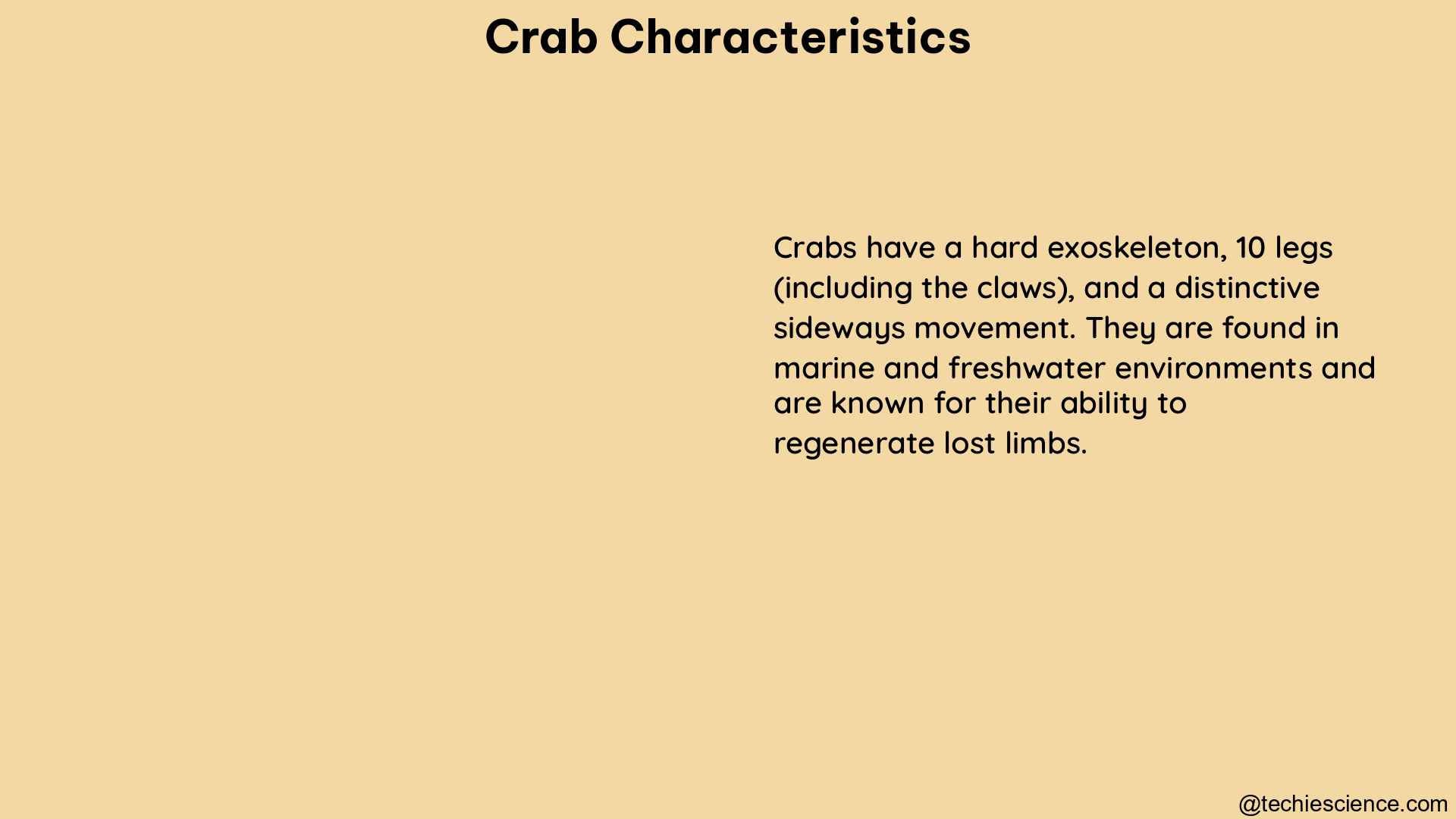Crabs, belonging to the Crustacea class, exhibit a remarkable array of characteristics that have captivated the attention of biologists and naturalists alike. From their intricate morphological diversity to their fascinating behavioral patterns and cognitive abilities, these remarkable crustaceans offer a wealth of insights into the natural world. In this comprehensive blog post, we will delve into the intricacies of crab characteristics, providing a detailed and informative guide for biology enthusiasts and students.
Morphological Diversity: Unveiling the Complexity of Crab Development
Crabs display a remarkable diversity in their morphological features, which can be observed across different developmental stages. This diversity is particularly evident when comparing the characteristics of true crabs and false crabs, as well as the various larval forms they undergo.
True Crabs vs. False Crabs: Contrasting Morphological Landscapes
True crabs and false crabs exhibit distinct patterns of morphological diversity. While adults of false crabs occupy the largest morphological space, the zoea larvae of true crabs show similarly extensive diversity. In contrast, the other developmental phases of both true and false crabs, such as megalopae, display smaller diversities, with megalopae having the smallest morphological variation.
| Developmental Phase | True Crabs | False Crabs |
|---|---|---|
| Adults | Moderate Diversity | Largest Diversity |
| Zoea Larvae | Largest Diversity | Moderate Diversity |
| Megalopae | Smallest Diversity | Smallest Diversity |
This variation in morphological diversity can be attributed to the unique adaptations and ecological niches occupied by these crustaceans throughout their life cycle. Understanding these patterns is crucial for researchers studying crab evolution, ecology, and developmental biology.
Quantifying Morphological Diversity
Researchers have employed various techniques to quantify the morphological diversity of crabs. One such approach involves the use of geometric morphometrics, which analyzes the shape and size of specific anatomical features. By comparing the landmark coordinates of different crab specimens, scientists can construct morphological spaces and assess the degree of diversity within and across developmental stages.
For example, a study on the morphological diversity of false crab adults revealed that they occupy the largest morphological space, as evidenced by the extensive variation in their carapace shape, limb proportions, and other key features (Table 1, Fig. 2A). In contrast, the megalopae of both true and false crabs exhibited the smallest morphological diversity, suggesting a more constrained developmental trajectory during this critical transition phase.
Implications for Crab Ecology and Evolution
The observed patterns of morphological diversity in crabs have important implications for their ecology and evolutionary adaptations. The extensive diversity observed in adult false crabs, for instance, may reflect their ability to exploit a wide range of ecological niches, from rocky shores to mangrove habitats. Conversely, the smaller diversities seen in megalopae could be linked to the need for a more streamlined body plan during this pelagic larval stage, which facilitates dispersal and settlement.
Understanding these morphological trends can provide valuable insights into the evolutionary history and adaptive strategies of crabs, as well as their ecological roles within complex marine and estuarine ecosystems.
Behavioral Personality: Quantifying the Individuality of Crabs

In addition to their morphological diversity, crabs also exhibit fascinating behavioral patterns that can be characterized as individual personality traits. Researchers have delved into the study of crab personality, shedding light on the cognitive and behavioral complexities of these remarkable crustaceans.
Personality Traits in Terrestrial Hermit Crabs
One of the well-studied examples of crab personality is found in the terrestrial hermit crab, Coenobita clypeatus. These crabs have been shown to exhibit consistent individual behavioral differences, which can be quantified and analyzed as personality traits.
Using a generalized linear mixed-effect model (GLMM), researchers have examined the learning and memory retention abilities of C. clypeatus in a spatial task. The results revealed that:
- Over the course of 11 trials, the crabs showed a significant decrease in the time taken to solve the task (Est = -0.09 ± 0.02, p < 0.001), indicating their ability to learn and improve their performance.
- In memory retention tests, the crabs spent significantly more time exploring the previously rewarded quadrant of the arena, demonstrating their capacity for spatial long-term memory.
These findings suggest that terrestrial hermit crabs possess distinct personality traits, such as learning ability and spatial memory, which can be quantified and compared across individuals.
Implications for Crab Cognition and Ecology
The discovery of individual behavioral consistency in crabs has important implications for our understanding of their cognitive abilities and ecological adaptations. Crab personality traits, such as learning, memory, and exploration, may play a crucial role in their survival, resource acquisition, and social interactions within their respective habitats.
Furthermore, the ability to quantify crab personality traits opens up new avenues for research in areas like animal cognition, decision-making, and the evolution of complex behaviors. By studying the underlying mechanisms and ecological consequences of crab personality, scientists can gain valuable insights into the broader evolutionary and ecological processes that shape the diversity of life.
Spatial Memory: Crabs’ Remarkable Cognitive Abilities
In addition to their behavioral personality, crabs have also demonstrated remarkable cognitive abilities, particularly in the realm of spatial memory. Terrestrial hermit crabs, such as Coenobita compressus, have been shown to possess allocentric spatial long-term memory, which allows them to navigate their environment and remember the locations of important resources.
Spatial Learning and Memory Retention in Hermit Crabs
Researchers have conducted experiments to assess the spatial memory capabilities of C. compressus. In a visuospatial learning task, the crabs were trained to locate a reward based solely on visual cues in their environment. The results of this study revealed that:
- Crabs were able to retain a long-term spatial memory of the reward location for up to seven days, demonstrating their capacity for allocentric spatial memory.
- During the training phase, the distance travelled by the crabs to reach the reward decreased, indicating their ability to learn the task.
- In the memory retention tests, the distance travelled by the crabs increased compared to the training phase, but this change was not statistically significant.
These findings suggest that terrestrial hermit crabs possess a remarkable ability to form and retain long-term spatial memories, which is crucial for their survival and navigation within their complex environments.
Implications for Crab Ecology and Cognition
The spatial memory capabilities of crabs have important implications for their ecology and evolutionary adaptations. The ability to remember the locations of resources, such as food sources, shelters, and potential mates, can provide crabs with a significant advantage in their struggle for survival and reproduction.
Furthermore, the study of crab spatial memory contributes to our understanding of the evolution of cognitive abilities in crustaceans. Comparing the spatial memory performance of different crab species, as well as their related ecological and behavioral traits, can shed light on the selective pressures and adaptive strategies that have shaped the cognitive complexity of these remarkable creatures.
Conclusion
Crabs, members of the Crustacea class, exhibit a remarkable array of characteristics that have captivated the attention of biologists and naturalists. From their intricate morphological diversity to their fascinating behavioral patterns and cognitive abilities, these crustaceans offer a wealth of insights into the natural world.
Through the exploration of crab morphological diversity, behavioral personality, and spatial memory, we have gained a deeper understanding of the complex adaptations and evolutionary strategies that have enabled these remarkable creatures to thrive in diverse aquatic and terrestrial environments.
As we continue to unravel the mysteries of crab characteristics, we can expect to uncover even more fascinating insights that will contribute to our broader understanding of the natural world and the remarkable diversity of life on our planet.
References
- Rufino, M. M., Abelló, P., & Yule, A. B. (2004). Male and female carapace shape differences in Liocarcinus depurator (Decapoda, Brachyura): an application of geometric morphometrics. Italian Journal of Zoology, 71(1), 79-83.
- Gherardi, F., Aquiloni, L., & Tricarico, E. (2012). Behavioral plasticity, social behavior, and communication in crustaceans. Biological Reviews, 87(1), 21-39.
- Zeil, J., & Hemmi, J. M. (2006). The visual ecology of fiddler crabs. Journal of Comparative Physiology A, 192(1), 1-25.
- Chiussi, R., Diaz, H., Rittschof, D., & Forward Jr, R. B. (2001). Orientation of the hermit crab Clibanarius antillensis: effects of visual and chemical cues. Journal of Crustacean Biology, 21(3), 593-605.
- Briffa, M., Bridger, D., & Biro, P. A. (2013). How does temperature affect behaviour? Multilevel analysis of plasticity, personality and predictpredictability in hermit crabs. Animal Behaviour, 86(1), 47-54.

Hello, I am Bhairavi Rathod, I have completed my Master’s in Biotechnology and qualified ICAR NET 2021 in Agricultural Biotechnology. My area of specialization is Integrated Biotechnology. I have the experience to teach and write very complex things in a simple way for learners.